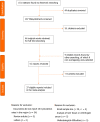Occult hepatitis C virus infection in the Middle East and Eastern Mediterranean countries: A systematic review and meta-analysis
- PMID: 33708353
- PMCID: PMC7934012
- DOI: 10.4254/wjh.v13.i2.242
Occult hepatitis C virus infection in the Middle East and Eastern Mediterranean countries: A systematic review and meta-analysis
Abstract
Background: The presence of hepatitis C virus (HCV) RNA in liver tissue or peripheral blood mononuclear cells with no identified virus genome in the serum has been reported worldwide among patients with either normal or elevated serum liver enzymes. The characterization of occult HCV infection (OCI) epidemiology in the Middle East and Eastern Mediterranean (M and E) countries, a region with the highest incidence and prevalence rates of HCV infection in the world, would be effective for more appropriate control of the infection.
Aim: To estimate the pooled prevalence of OCI in M and E countries using a systematic review and meta-analysis.
Methods: A systematic literature search was performed using international, regional and local electronic databases. Some conference proceedings and references from bibliographies were also reviewed manually. The search was carried out during May and June 2020. Original observational surveys were considered if they assessed the prevalence of OCI among the population of M and E countries by examination of HCV nucleic acid in peripheral blood mononuclear cells in at least 30 cases selected by random or non-random sampling methods. The meta-analysis was performed using Comprehensive Meta-analysis software based on heterogeneity assessed by Cochran's Q test and I-square statistics. Data were considered statistically significant at a P value < 0.05.
Results: A total of 116 non-duplicated citations were found in electronic sources and grey literature. A total of 51 non-overlapping original surveys were appraised, of which 37 met the inclusion criteria and were included in the analysis. Data were available from 5 of 26 countries including Egypt, Iran, Pakistan, Saudi Arabia, and Turkey. The overall prevalence rate of OCI was estimated at 10.04% (95%CI: 7.66%-13.05%). The lowest OCI rate was observed among healthy subjects (4.79%, 95%CI: 2.86%-7.93%). The higher rates were estimated for patients suffering from chronic liver diseases (12.04%, 95%CI: 5.87%-23.10%), and multi-transfused patients (8.71%, 95%CI: 6.05%-12.39%). Subgroup analysis indicated that the OCI rates were probably not associated with the studied subpopulations, country, year of study, the detection method of HCV RNA, sample size, patients' HCV serostatus, and sex (all P > 0.05). Meta-regression analyses showed no significant time trends in OCI rates among different groups.
Conclusion: This review estimated high rates of OCI prevalence in M and E countries, especially among multi-transfused patients as well as patients with chronic liver diseases.
Keywords: Eastern Mediterranean region; Meta-analysis; Middle East; Occult hepatitis C; Prevalence; Review.
©The Author(s) 2020. Published by Baishideng Publishing Group Inc. All rights reserved.
Conflict of interest statement
Conflict-of-interest statement: The authors deny any conflict of interest.
Figures




Similar articles
-
Global prevalence of occult hepatitis C virus: A systematic review and meta-analysis.World J Methodol. 2022 May 20;12(3):179-190. doi: 10.5662/wjm.v12.i3.179. eCollection 2022 May 20. World J Methodol. 2022. PMID: 35721241 Free PMC article.
-
Epidemiology of occult hepatitis B and C in Africa: A systematic review and meta-analysis.J Infect Public Health. 2022 Dec;15(12):1436-1445. doi: 10.1016/j.jiph.2022.11.008. Epub 2022 Nov 12. J Infect Public Health. 2022. PMID: 36395668 Free PMC article.
-
Prevalence of Hepatitis C Virus Genotypes Among Patients in Countries of the Eastern Mediterranean Regional Office of WHO (EMRO): A Systematic Review and Meta-Analysis.Hepat Mon. 2016 Apr 19;16(4):e35558. doi: 10.5812/hepatmon.35558. eCollection 2016 Apr. Hepat Mon. 2016. PMID: 27274353 Free PMC article. Review.
-
Occurrence of occult HCV infection among Hiv infected patients in Georgia.Georgian Med News. 2014 Jan;(226):37-41. Georgian Med News. 2014. PMID: 24523330
-
The HBsAg Prevalence Among Blood Donors From Eastern Mediterranean and Middle Eastern Countries: A Systematic Review and Meta-Analysis.Hepat Mon. 2016 Mar 26;16(3):e35664. doi: 10.5812/hepatmon.35664. eCollection 2016 Mar. Hepat Mon. 2016. PMID: 27226804 Free PMC article. Review.
Cited by
-
Global prevalence of occult hepatitis C virus: A systematic review and meta-analysis.World J Methodol. 2022 May 20;12(3):179-190. doi: 10.5662/wjm.v12.i3.179. eCollection 2022 May 20. World J Methodol. 2022. PMID: 35721241 Free PMC article.
-
Epidemiology of occult hepatitis B and C in Africa: A systematic review and meta-analysis.J Infect Public Health. 2022 Dec;15(12):1436-1445. doi: 10.1016/j.jiph.2022.11.008. Epub 2022 Nov 12. J Infect Public Health. 2022. PMID: 36395668 Free PMC article.
-
Unraveling IL-17 and IL-22 role in occult hepatitis C versus chronic hepatitis C virus infection.BMC Infect Dis. 2024 Jan 25;24(1):134. doi: 10.1186/s12879-024-09032-6. BMC Infect Dis. 2024. PMID: 38273234 Free PMC article.
-
Occult hepatitis C infection identified in injection drug users with direct antiviral agents therapy and spontaneous resolution of hepatitis C virus infection.Virus Res. 2023 May;329:199104. doi: 10.1016/j.virusres.2023.199104. Epub 2023 Apr 2. Virus Res. 2023. PMID: 37003528 Free PMC article.
-
Characterization of the Human Blood Virome in Iranian Multiple Transfused Patients.Viruses. 2023 Jun 23;15(7):1425. doi: 10.3390/v15071425. Viruses. 2023. PMID: 37515113 Free PMC article.
References
-
- World Health Organization (WHO) Global health sector strategy on viral hepatitis, 2016–2021. Towards ending viral hepatitis. Geneva, Switzerland: World Health Organization. 2016. Available from: https://www.who.int/hepatitis/strategy2016-2021/ghss-hep/en .
-
- Castillo I, Pardo M, Bartolomé J, Ortiz-Movilla N, Rodríguez-Iñigo E, de Lucas S, Salas C, Jiménez-Heffernan JA, Pérez-Mota A, Graus J, López-Alcorocho JM, Carreño V. Occult hepatitis C virus infection in patients in whom the etiology of persistently abnormal results of liver-function tests is unknown. J Infect Dis. 2004;189:7–14. - PubMed
-
- Daef EA, Makhlouf NA, Ahmed EH, Mohamed AI, Abd El Aziz MH, El-Mokhtar MA. Serological and Molecular Diagnosis of Occult Hepatitis B Virus Infection in Hepatitis C Chronic Liver Diseases. Egypt J Immunol. 2017;24:37–48. - PubMed
LinkOut - more resources
Full Text Sources
Other Literature Sources
Miscellaneous

